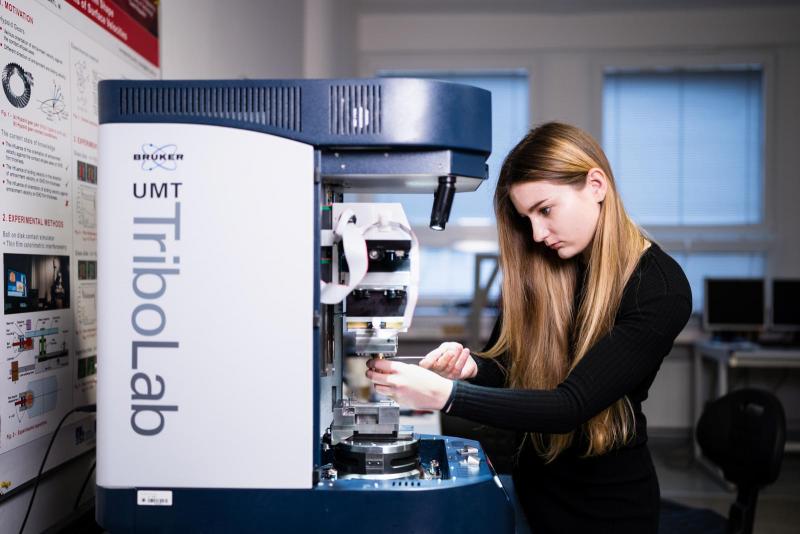Ideas and discoveries
22 November 2023
Alexandra Streďanská’s fascination with fascia and hyaluronic acid

Without exaggeration, back pain could be called the most widespread civilization disease. According to current research, non-specific lower back pain may be caused by underused or, on the contrary, overloaded fascia. These membrane sheaths of our muscles are studied by Alexandra Streďanská, a doctoral student engaged in biotribology.
"Fascia is the tissue separating, for example, muscle from fat or individual muscle layers from each other and helps us move painlessly. However, because many people today have sedentary jobs, are lazy or, on the contrary, work out too much, both of these extremes lead to pathological changes in fascia and can potentially become a cause of non-specific lower back pain", explains Streďanská.
"Fascia is the tissue separating, for example, muscle from fat or individual muscle layers from each other and helps us move painlessly. However, because many people today have sedentary jobs, are lazy or, on the contrary, work out too much, both of these extremes lead to pathological changes in fascia and can potentially become a cause of non-specific lower back pain", explains Streďanská.
In high school she devoted herself to biology and chemistry, at university she moved from natural sciences to technical ones. Later, when choosing the focus of her PhD studies, she decided to combine both her passions and chose the so-called biotribology. The field on the border of technology, medicine and biology captivated her.
In the laboratory, she has recently been studying the aforementioned fasciae, which are more complex than it might seem at first glance. "They have several layers with hyaluronic acid in between. This acid is produced by the human body itself - specifically the fasciae are covered with cells that make it. However, if the fascia gets damaged, for example by a lack or excess of movement, or if hyaluronic acid is present in an inappropriate form such as in a non-optimal concentration or molecular weight, there occurs a problem for the patient," says Streďanská.
The question is how to study the processes of friction and lubrication in fasciae. Streďanská searched for the answer during her three years of research and seems to have found it. "First, we analysed the biological problem itself, that is, how fascia works in the human body, what surfaces interact with each other, how they move relative to each other... A great challenge was to find the most faithful artificial material that would be suitable for experiments and simulations. We compared all tested materials, from basic technical silicone to very high-tech materials, with rabbit fasciae. However, we are inclining towards the use of artificial materials, which, unlike animal materials, do not deteriorate so quickly, and naturally the ethics of our research also plays a big role," says Streďanská, adding that a suitable combination of artificial material simulating fascia and muscle has been found.
"Once we were satisfied with the configuration of our experiment, we began to test and measure the behaviour of the "artificial fascia" with various solutions and derivatives of hyaluronic acid. We are mainly interested in the behaviour of the solution between the fasciae, the goal is to come up with an optimal composition that would reduce friction and thus relieve people from pain. The solution could applied by ultrasound guided injection injected into the fascia layers and thus making it move again," says Streďanská, adding in the same time that such a preparation must, of course, undergo clinical studies and obtain all the necessary approvals.
Hyaluronic acid in the body works like a perfect lubricant.
Streďanská cooperated on the research not only with colleagues from the biotribological group, but also with Contipro, a company that led the research project. This national biotechnology company is one of the world leaders in the research and production of hyaluronic acid. The motivation for fasciae research is clear: a large number of people suffer from back problems, and the number of patients is constantly increasing. "It brings along socio-economic problems such as long-term and expensive treatment, reduced quality of life and social exclusion, impaired chances of employment," says Streďanská.
As part of her PhD studies, the young researcher got into an environment where, in addition to her knowledge of technology, she also needs a deeper dive in medicine or biology. "We do extensive research mainly at the beginning of a new topic, when it is necessary to study how which mechanisms in the body work and what could influence our experiments, which we naturally want to be as realistic as possible," says Streďanská, who had the opportunity to consult her research with experts from the aforementioned company Contipro, where she also had an internship.

A research project in which she examined fascia recently finished, but Streďanská continues to work on the topic. "Contipro managed to find the optimal properties of the solution for lubricating fascia, which we tested tribologically as part of our research. Now the company is conducting clinical trials and so far it seems to be successful, "says Streďanská, who would like to pursue a scientific career after obtaining her doctorate. "Hyaluronic acid in the body works like a perfect lubricant. And there are still a number of methods for analysing friction and lubrication of fasciae that we have not yet tried, "says Streďanská.
(ivu)
Auxetic material behaves differently than you would expect, says student Tomáš Vítek
Doctoral students in engineering study the behaviour of the circulatory system. Neural networks also help them
Chickens with their heads in the clouds
Matěj Štarha's love of technology led him to a deserted island
Optical fibres will help peek into the deepest parts of the brain. A doctoral student from FME is involved in the research